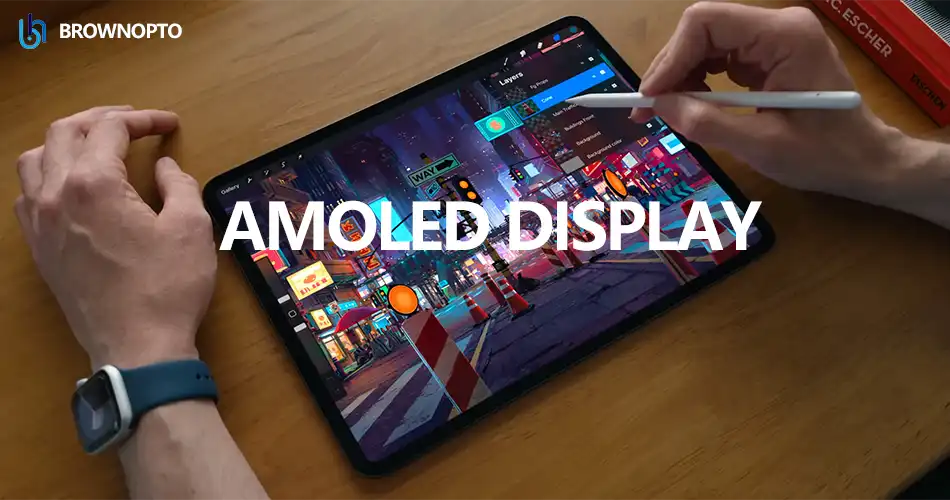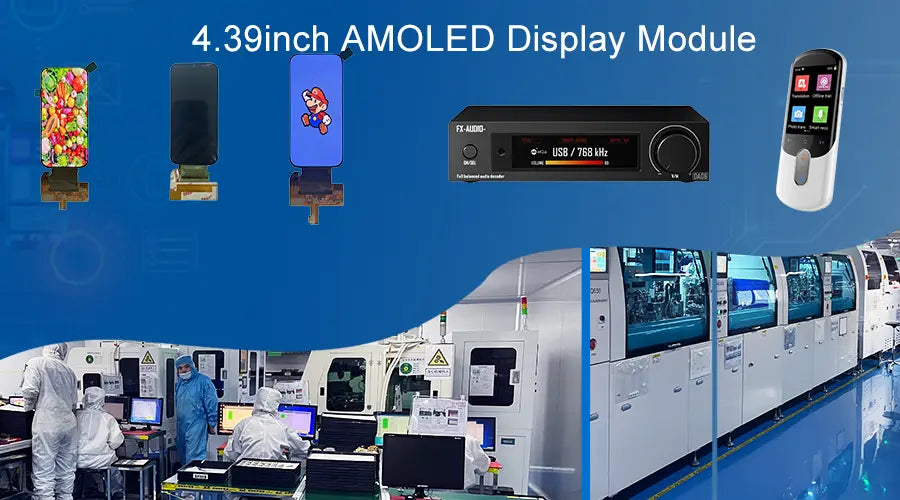Table of Contents
- Introduction
- What Does OLED Mean?
- What Does OLED Stand For?
- How Does OLED Work?
- Types of OLED Displays
- Advantages of OLED Displays
- Disadvantages / Limitations
- OLED vs IPS Displays
- Applications of OLED Displays
- Future Trends & Industry Insights
- Frequently Asked Questions (FAQ)
- Conclusion
Introduction
OLED, which stands for Organic Light Emitting Diode, has emerged as one of the most advanced display technologies today. It revolutionizes the way light is generated on screens by using organic compounds that emit light when an electric current is applied. This enables ultra-thin panels, vibrant colors, high contrast, and energy efficiency. OLED technology is widely adopted in TVs, monitors, laptops like the MacBook M4 OLED display, smartphones, wearable devices, and commercial signage.
In this comprehensive guide, we explore what OLED means, its working principle, types, advantages over IPS displays, applications, and future trends in the industry.
What Does OLED Mean?
The term OLED stands for Organic Light Emitting Diode. It describes a display technology in which each pixel emits its own light through an organic compound layer. Unlike LCDs, which require a backlight, OLED allows each pixel to emit light independently, resulting in true blacks and superior contrast ratios.
OLEDs can be classified into various types such as AMOLED (Active Matrix OLED) and PMOLED (Passive Matrix OLED). AMOLED is commonly used in high-resolution displays like smartphones, laptops, and monitors, while PMOLED is suitable for smaller devices such as wearable gadgets.

What Does OLED Stand For?
OLED stands for Organic Light Emitting Diode. The key part of this acronym is “Organic,” which refers to carbon-based materials used in the emissive layers. These organic materials emit photons when a voltage is applied, generating light. OLED displays do not require backlighting, enabling thinner and lighter designs.
Understanding what OLED stands for is fundamental for anyone exploring modern display technology and comparing it with other solutions like IPS, LED, or LCD.
How Does OLED Work?
Each OLED pixel contains organic molecules that emit light when an electric current passes through them. The main components are a substrate, an anode, a cathode, and organic layers, including the emissive layer. When voltage is applied, electrons and holes recombine within the emissive layer, releasing energy as light. Each pixel can emit its own color, allowing precise control over brightness, contrast, and color accuracy.
Advanced applications include flexible and foldable OLEDs used in devices like MacBook M4 OLED displays and smartphones. Unlike LCDs, OLEDs can achieve true black levels by turning off individual pixels, enhancing both image quality and energy efficiency.

Types of OLED Displays
AMOLED vs PMOLED
AMOLED uses a thin-film transistor (TFT) matrix to control each pixel individually, supporting high refresh rates and resolutions. PMOLED is simpler, suited for small screens with lower refresh rates.
Flexible and Foldable OLEDs
Flexible OLEDs use plastic substrates instead of glass, enabling bending and folding. Foldable smartphones and rollable TVs are enabled by this technology.
Transparent OLED
Transparent OLED panels allow light to pass through, ideal for retail displays and automotive applications.
OLED Monitors and TVs
OLED monitors and TVs offer superior color accuracy, contrast, and response times, enhancing gaming, professional editing, and home entertainment experiences.
Advantages of OLED Displays
- Superior contrast: Each pixel can turn off completely for true blacks.
- Vivid colors: Organic materials produce accurate and vibrant colors.
- Wide viewing angles: Minimal color shift from extreme angles.
- Thin and lightweight: No backlight needed, enabling ultra-thin panels.
- Energy efficiency: Dark scenes consume less power.
- Fast response times: Excellent for gaming and dynamic visuals.
Disadvantages / Limitations
- Higher manufacturing costs than LCDs.
- Potential burn-in with static images.
- Blue OLED material degrades faster than red/green.
- Environmental sensitivity to moisture and oxygen.
OLED vs IPS Displays
IPS (In-Plane Switching) is a type of LCD known for wide viewing angles and accurate colors. However, OLED displays offer better contrast, true blacks, thinner panels, faster response times, and energy efficiency.
- True blacks vs backlit blacks
- Thinner design
- Faster response
- Energy saving in dark scenes
For high-end devices, OLED often provides a superior user experience compared to IPS.

Applications of OLED Displays
Televisions
OLED TVs deliver cinematic visuals with deep blacks and vivid colors.
Monitors and Laptops
OLED monitors and laptops, including MacBook M4 OLED display, provide high resolution, fast refresh rates, and accurate colors for gaming and professional work.
Smartphones and Tablets
AMOLED smartphones benefit from vibrant colors, energy efficiency, and slim designs.
Wearables
Smartwatches and fitness devices use OLED for small, efficient, bright displays.
Advertising and Commercial Displays
Flexible and transparent OLED displays enhance digital signage and retail advertising.
Automotive Displays
Used in dashboards and infotainment systems for high contrast and wide viewing angles.

Future Trends & Industry Insights
Emerging trends include flexible, foldable, and micro-OLED panels, higher refresh rates, 8K resolutions, and applications in AR/VR. As production costs decrease, OLED adoption will expand across consumer and commercial devices.
Frequently Asked Questions (FAQ)
What does OLED mean?
Organic Light Emitting Diode; each pixel emits its own light.
How does OLED work?
Electric current passes through organic layers, emitting light per pixel.
What is the advantage of OLED over IPS?
Better contrast, true blacks, faster response, thin design, energy efficiency.
Is MacBook M4 OLED display?
Yes, selected models feature OLED screens for high color accuracy and energy efficiency.
What is an OLED TV display?
TV display with self-emitting pixels for deep blacks and vibrant colors.
Can OLED displays be customized?
Yes, sizes, shapes, flexible designs, and transparent panels can be customized.
Conclusion
OLED displays offer revolutionary visual performance with deep blacks, vibrant colors, and energy efficiency. From TVs to monitors, smartphones, laptops, and wearables, OLED is shaping the future of displays for both consumers and industry professionals.





Leave a comment
This site is protected by hCaptcha and the hCaptcha Privacy Policy and Terms of Service apply.